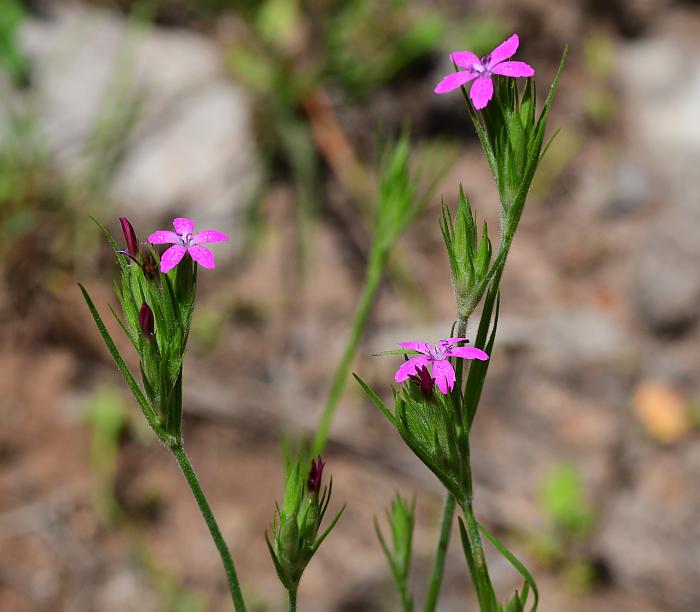Dianthus armeria L.
Deptford Pink

Introduced
CC = *
CW = 5
MOC = 82
© SRTurner
Dianthus armeria L.Deptford Pink | |
 |
Introduced CC = * CW = 5 MOC = 82 |
© SRTurner |
|
Family - Caryophyllaceae Habit - Taprooted annual or biennial forb. Stems - Erect, to 90 cm, unbranched or branched at the base, glabrous or moderately pubescent with curled hairs, mostly at the nodes and toward the tip, terete, hollow.
Leaves - Opposite, sessile, 2.0-10.5 cm long, linear to narrowly oblanceolate, entire, pubescent, angled to a bluntly (most basal leaves) or sharply pointed tip.
Inflorescence - Flowers solitary or 3-6 in relatively dense clusters, appearing nearly sessile, the stalks 0.1-0.3 cm long. Inflorescence bracts present. Epicalyx of 4 bracts, these 3/4-1 times as long as the sepals, the margins herbaceous and green.
Flowers - Sepals 12-19 mm long, the tube 20-25-veined, sparsely to densely pubescent with minute, more or less appressed hairs; the lobes linear, tapered to a sharply pointed tip. Petals 15-27 mm long, the expanded portion 3-8 mm long, 5-lobed, irregularly toothed at the tip, pinkish red to purplish red, spotted with white. Stamens 10. Filaments to 1.4 cm long, filiform, glabrous, white. Anthers purple, 1.2 mm long, slightly exserted or included. Styles 2, filiform, white, 1 cm long, included. Ovary cylindric, 6-7 mm long, 1.2 mm in diameter, glabrous, light green, 2-locular. Placentation axile. Ovules numerous.
Fruits - Capsules 10-16 mm long. Seeds 1.1-1.4 mm long.
Flowering - May - October. Habitat - Glades, upland prairies, tops of bluffs, upland forest openings, pastures, fields, fencerows, railroads, roadsides, open disturbed areas. Also cultivated. Origin - Native to Europe. Lookalikes - None when flowering. Other info. - This slender, pretty species is common throughout Missouri, and is also found, in somewhat more scattered fashion, across the continental U.S. It is easily recognized by the spotted pink flowers, which are unique in appearance among Missouri's flora. Though introduced, the plant is generally non-aggressive and well-behaved in wild areas. The colorful flowers make the species desirable in cultivation, and it requires little care. Plants in Missouri have been assigned to ssp. armeria. Photographs taken in the Ozark Scenic Riverways, 5-24-03 (DETenaglia); also at Weldon Spring Conservation Area, St. Charles County, MO, 5-27-2010 and 5-23-2012, Grand Trace Conservation Area, Harrison County, MO, 6-13-2014, Tingler Prairie Natural Area, Howell County, MO, 6-10-2021, and Shaw Nature Reserve, Franklin County, MO, 7-10-2021 (SRTurner). |